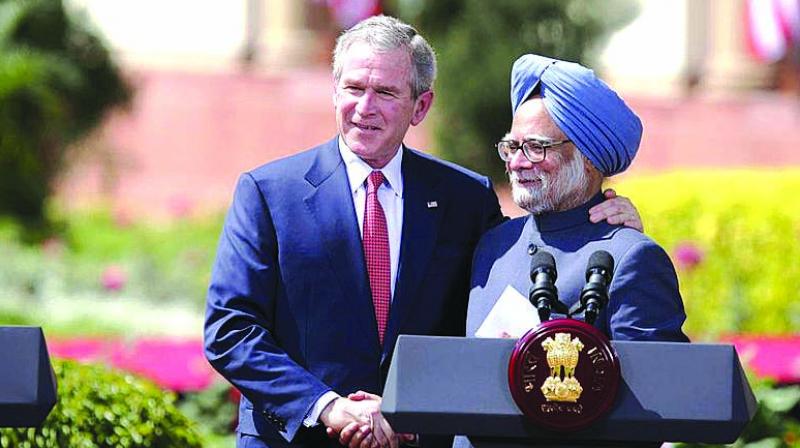On Thursday evening, India lost its soft-spoken former prime minister who was known as the chief architect of the modern-day Indian economy. Veteran Congress leader Dr Manmohan Singh passed away in New Delhi at age 92. His death was confirmed in a statement issued by the All India Institute of Medical Sciences, the hospital where he died.
Recalling the contribution made by Singh in his decades-long political career, Prime Minister Narendra Modi mourned the loss and went on to call him the “most distinguished leader”. With his trademark light blue turban and his degree in economics from Oxford, Singh became a powerhouse of an individual, bringing reforms that laid the foundation of India’s growth and development.
While the world lauds Singh for his economic acumen, less is talked about his foreign policy achievements, especially when it comes to building ties with the United States. During his time as India’s Prime Minister, Singh dealt with two American presidents, i.e. George W. Bush and Barack Obama. Be it Republican or Democrat, Singh maintained a fine balance between the two leaders, which ultimately benefited New Delhi. Here’s a look at how Singh did it.
Singh can be seen as a game-changer in India’s foreign policy in the post-Cold War era. He was the key player in ushering in a pathbreaking Indo-US nuclear deal under Republican firebrand George W. Bush’s administration. During his tenure, Singh fostered a strong relationship with Bush which ultimately led to the signing of the United States-India Nuclear Cooperation Approval and Non-proliferation Enhancement Act on October 8, 2008.
The framework of the deal was laid out in 2005, following lengthy exchanges between the leaders. The reason the ratification was delayed was due to the challenges both nations faced in their respective homes. The deal came at a time when India’s nuclear power facilities were facing shortages of Uranium. While imports of Uranium were restricted since the West was still angry with India’s nuclear capabilities, 2008 saw a surge in crude oil prices.
This forced the government to raise fuel prices which did not sit well with some of the Congress’ allies. Amid the chaos, Singh started looking for alternatives and pushed for the Indo-US nuclear deal. This angered Congress’ Key Ally the Left Front, which was supporting the UPA government from outside. The Left Front demanded the rollback of the rise in fuel prices and strongly opposed the nuclear deal. They argued that such a deal with the US would compromise India’s independent policy.
After a lot of back and forth, Left Front withdrew its support in July 2008 after India formally approached the International Atomic Energy Agency (IAEA) for the Indo-US Nuclear Deal. A vote of no confidence was called against the Singh cabinet, which he ultimately survived. After surviving the vote, Singh still pushed for the deal in his address to the parliament.
“I am convinced that despite their opportunistic opposition to the nuclear agreement, history will compliment the UPA Government for having taken another giant step forward to lead India to become a major power centre of the evolving global economy…” he said during his reply to the motion.
The deal eventually helped India to gain a strong standing in the world as a nuclear power. It gave New Delhi the acceptance it was seeking after being shunned by the West for conducting nuclear tests on its own.
When Obama came to power, the world especially the United States was facing a global financial crisis. While the world was witnessing a crash Singh took the initiative to boost foreign investments in India, safeguarding the country from the 2008 recession.
Not just Obama, former British Chancellor Gordon Brown, ex-Japan PM Shinzo Abe and ex-German Chancellor Angela Merkel praised him for his work at that time, calling him a “financial guru”. Nine years later Obama recalled how Singh was a strong support during the whole saga.
“Singh was the primary partner while we were working during the financial meltdown (of 2008),” the former president averred, calling him a “great friend”. Obama also mentioned Singh in his memoir titled “A Promised Land”.
While the mention of India in the book garnered controversies, Obama only had nice things to say about Singh. The former president recalled that Singh was the “chief architect of India’s economic transformation” and “wise, thoughtful, and scrupulously honest”. “Singh was a self-effacing technocrat who’d won the people’s trust not by appealing to their passions but bringing about higher living standards and maintaining a well-earned reputation for not being corrupt,” Obama wrote in his book.
“While he would be cautious in foreign policy, unwilling to get out too far ahead of an Indian bureaucracy that was historically suspicious of US intentions, our time together confirmed my initial impression of him as a man of uncommon wisdom and decency,” he added.
Apart from this India and the US also collaborated in 2007 when Japan’s former Prime Minister Shinzo Abe proposed the idea of the Quad during his visit to India. Four nations who were part of the Quad were: Japan, India, Australia and the United States. The group still collaborates on several issues.
Overall, Singh’s strong ties with both Bush and Obama laid the foundation of the strong India-US ties. Singh’s quote that “India-US came out of the hesitation of history,” still resonates with the relationship between the two reasons. It was ultimately Singh’s shoulder on which India stood to remain at par with the United States in the hegemonic era.
Link to article –
Bush & Obama: How Manmohan Singh turned US presidents into friends



